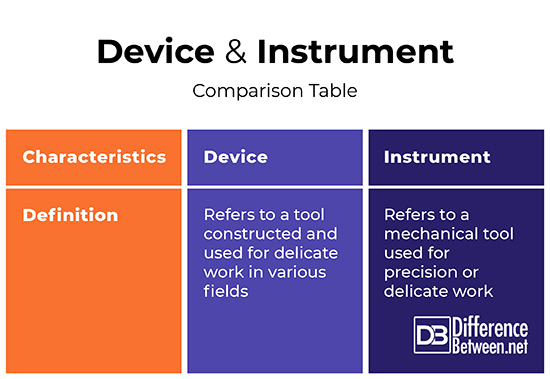In the realms of science and technology, the terms “equipment” and “instrument” are frequently employed, often interchangeably. However, a nuanced distinction separates these two concepts, reflecting their distinct functions and applications within various disciplines. Inexplicably intertwined, equipment and instruments serve pivotal roles in experimental setups, yet they are defined by their unique characteristics and operational paradigms. This article endeavors to elucidate the differences between equipment and instruments in a manner that invites intellectual curiosity while also providing a comprehensive understanding of their roles across varied fields.
To commence, it is essential to establish what constitutes equipment. Equipment refers to the broad category of tools and machinery utilized to perform specific tasks or functions. This encompasses a plethora of devices ranging from basic hand tools, like hammers and screwdrivers, to complex machinery such as centrifuges and spectrometers. The primary characteristic that delineates equipment is its fundamental purpose: to facilitate the process of work or production. In many cases, equipment can exist independently and is often designed for general applications across numerous contexts.
In stark contrast, the term “instrument” conveys a more specialized connotation. Instruments are designed primarily for measurement, analysis, and the precise manipulation of variables. They are the tools of scientists, engineers, and technicians, meticulously engineered to yield quantitative or qualitative data. Examples of instruments include thermometers, voltmeters, and gas chromatographs. Instruments typically embody sophistication in their design and calibration, ensuring accuracy and reliability in their measurements.
One might wonder why this distinction matters. Within the scientific community, the precision and specificity afforded by instruments can drastically affect experimental outcomes. The utilization of improper equipment when precision is required can lead to significant errors, thereby invalidating results. Conversely, instruments lacking robust construction may yield data that is inconsistent or unreliable. This dichotomy becomes particularly salient in fields such as physics, chemistry, and engineering, where the line between measurement and operational functionality can blur.
In examining the broader implications of these definitions, it is instructive to consider the evolution of scientific practices. Historically, the reliance on rudimentary tools (equipment) laid the foundation for early scientific inquiry. As knowledge expanded, so too did the complexity of the tools employed. The advent of sophisticated instruments marked a paradigm shift, allowing for unprecedented advancements in fields such as biology and material science. This transformation underscores a deeper philosophical observation: the evolution of equipment into instruments corresponds intricately with the evolution of scientific understanding itself.
The inherent design and purpose of instruments lend themselves to discussions surrounding calibration and accuracy. Many instruments must undergo regular calibration to maintain their precision. This is particularly crucial in disciplines such as metrology, where measurement integrity is paramount. Calibration processes often involve the use of standardized references, thereby establishing trust in the data collected. This concept is less applicable to general equipment, which may not necessitate such rigorous checks. Thus, while one may employ a wrench (equipment) in various settings with relative ease, the same cannot be said for a spectrophotometer (instrument), which demands precise operation and occasional recalibration.
The operational boundaries of equipment and instruments extend beyond the physical constructs to encompass their roles in research and development. In laboratory environments, equipment often serves as the backbone, supporting experimental setups through provision and facilitation. Instruments, however, take center stage, driving discoveries by rendering invisible phenomena observable. This dynamic interplay is critical; the absence of either can hinder progress. For example, in laboratories investigating chemical reactions, the calorimeter (instrument) provides essential data on heat changes, while the array of glassware (equipment) serves to hold and manipulate reactants.
Another notable distinction lies in the aspect of user interaction. Equipment often requires a broader skill set for operation, as it may involve various mechanics and assembly processes. Conversely, instruments tend to be more user-friendly in design, albeit necessitating a comprehensive understanding of the principles they measure. In educational settings, this difference shapes how students engage with scientific inquiry. Equipment may promote hands-on practical skills, while instruments cultivate analytical reasoning and critical thinking regarding data interpretation.
Furthermore, innovation in both realms continues unabated. Modern trends witness an increasing convergence of equipment and instruments. For instance, contemporary devices may integrate both functionalities—think of multifunctional analytical machines that not only prepare samples but also perform meticulous analyses. This trend represents a holistic approach to practicality, allowing for streamlined workflows and enhanced efficiency in laboratories.
In conclusion, while the terms “equipment” and “instrument” may be used interchangeably in casual discourse, a meticulous examination reveals significant distinctions rooted in functionality, complexity, and application. Equipment serves as the structural foundation for tasks, while instruments refine scientific measurement and inquiry. Understanding these nuances is not merely an academic exercise but rather an essential engagement with the finer aspects of scientific exploration. As technology continues to evolve, so too will the relationship between equipment and instruments, hinting at new frontiers of innovation and discovery that beckon researchers and scientists alike.










